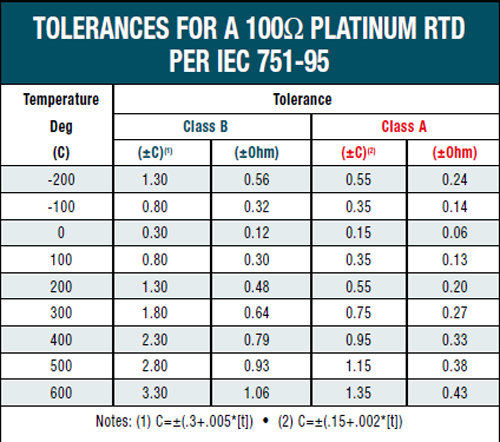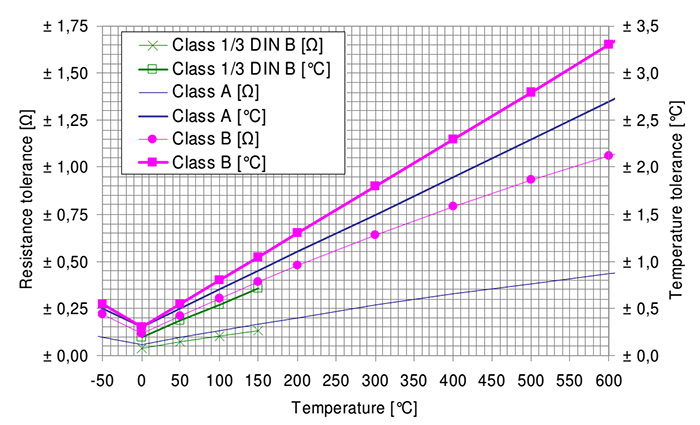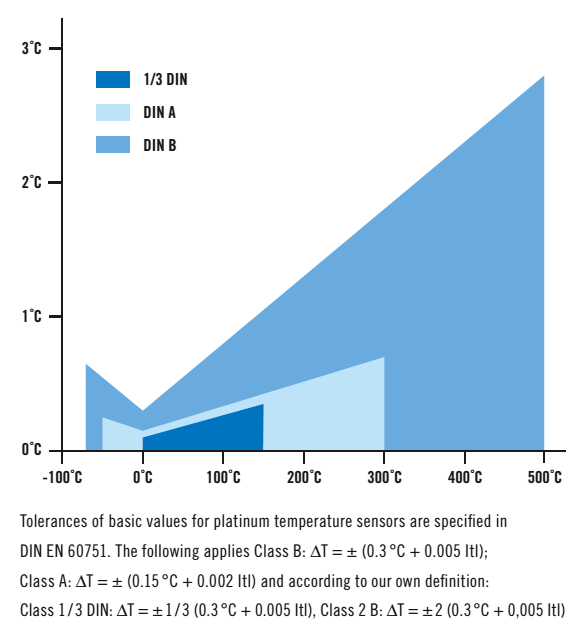RTD Sensor Accuracy and Tolerance Standards
RTD Sensor Accuracy and Tolerance Standards

The industry standard for platinum RTD's according to IEC-751 is + /- 0.12% (of resistance) at 0°C, commonly referred to as Class B accuracy. This will provide an accuracy of + /- 0.3°C at 0°C, which is quite good if you compare it to the + /- 2.2°C of a standard Type J or K thermocouple. But as the temperature increases, so does the permissible deviation due to the variations possible in the TC. So, not only do we have the possible + /- .3°C offset at 0°C, but also the probability that the TC is not equal to 0.00385. This could account for a permissible deviation of up to + /- 4.6°C at a maximum temperature of 850°C . But that's still better than the K thermocouple, which could be off by as much as + /- 6.4°C, and even more for the Type J, which is not recommended at this temperature. Because a well manufactured RTD will have high repeatability (relative to the application), Class B accuracy is generally sufficient unless there is a need for better interchangeability; or when measuring change of temperature; or if you know that you have special accuracy requirements.
When Class B accuracy is not quite enough, the International Electrotechnical Commission (IEC) offers us Class A accuracy, which permits + /- 0.15°C at 0°C and much tighter control of the TC. To ensure this control, the single ice point calibration acceptable for Class B sensors will not suffice. The IEC therefore states in section 4.2.2 of Standard 751. "The test for Class A thermometers shall be carried out at two or more temperatures suitably spaced over the stated working range".
The minimum and maximum temperatures of the stated working range are conve-nient points to chose and will ensure Class A accuracy, but will at the same time tend to drive up the cost of the sensor. It is more practical to look the application. If need to control the process most closely at 37°C, for example, choose a range from 0°C to 50°C This will fulfill your requirements without needlessly increasing costs or manufacturing restrictions. But remember, when specifying a Class A RTD, you must always include the working range at which it must perform to this accuracy.
Another word on Class A and Class B RTD's. These are IEC designations of accuracy. Although conforming to the use of a 0.00385 TC, the ASTM has its own designations of Grade A and Grade B that differ slightly from the IEC permissible deviations.
Of course, classes A and B or grades A and B cannot cover every possible accuracy specification desired. Then you need to spell out your requirements for the applications engineer. If your SPC/SQC charts indicate that you need to control a specific process within + /- 0.5°C at 250°C, even a Class A RTD will not do the job. As we discussed earlier, you may not actually need the accuracy at this point, but rather the repeatability. But if you believe that starting with an accurate sensor is the first step toward tight control of the process, request an accuracy of + /- 0.5°C at 250°C, or over the range of 200°C to 300°C. This is not unrealistic for a well-made RTD, although it requires special selection of the sensing element at this temperature. Keep in mind that this special selection will generally result in a longer delivery time and higher price tag on the RTD. Conversely, not all applications require even Class B accuracy. If you need to know only, "Is it hot or is it not?" can generally appreciate some savings by requesting a less accurate sensor that will still suit your needs.
All too often the specification will read something like "Accuracy within + /- 1.0%". My question: "Percent of what?" If it is meant to be percent of indicated value we need to clarify a few things. There are four primary temperature scales in use today. Kelvin and Rankine, which are absolute temperature scales, and Celsius and Fahrenheit, which are not. Let's take the freezing point of water in Celsius for example. What is + /- 1.0% of temperature accuracy at 0°C? A perfect reading? Possible, but not likely. If we were reading this in Fahrenheit the tolerance would be + /- 0.32°F; in Kelvin, it would be + /- 2.73°K, which equals + /- 2.73°C. So which is right? None. The specification was poorly written.It is acceptable, however, to use percent for % F.S. if you clearly state what the scale will be.
Or we can say percent of resistance at a given temperature, as the IEC does for the nominal resistance of a Class B RTD; 100 ohm,+ /- 0.12% at 0°C. Aside from these cases, it is generally better to state your requirements in terms of temperature tolerance in degrees over the temperature range where it is actually required.


sales@thermometricscorp.com